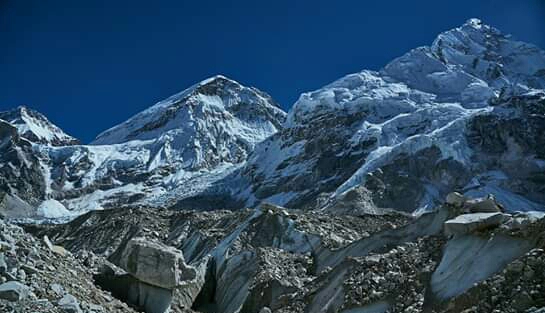
Nepal may move Everest Base Camp, from its present location due to the strong greenhouse effect and global warming. Mt. Everest Base Camp is on the brink of extinction, where glaciers are receding and the snow, and ice are melting. Everest Base Camp is the Famous for its Everest Base Camp trek.
The changes are happening so fast as well Mt. Everest has also grown a little higher. From the previous height of 8,848 m / 29,028 feet to the present new 8,848.86 m and 29,031.69 feet high.
The movement of glaciers and the rise in height of various peaks make the present Everest base camp much more complex. As well as unsafe soon, the change of climate along with global warming and mass volume of mountaineers.
Makes the fragile surrounding of Mt. Everest base camp lost its charm and beauty, which it is now. Will soon disappear falling or rocks and fast flow of ice-falls and glaciers, which is melting fast speeds.
To save the present Everest base camp from further destruction, which is at 5,364 m / 17, 598 feet high.
The main reason for the melting of ice, and snow at unpredictable times and speeds is due to the mass flow of mountaineers. Making their base camp for a minimum of one month to a maximum of two months.
The commotion and activities of mountaineers and crews involved in the expeditions, create much damage to the pristine environment.
Mt. Everest straddles the border with Tibet / China and Nepal, where Nepalese sides of the south base camp. Which is more crowded with trekkers and mountaineering expeditions, than the North side of Tibet base camp.
The North Base Camp on the Tibet / China side is a wide and large area for base camp. Which is quite far from the bottom of Mt. Everest, then on the Nepal side of the base camp. Makes a great difference on the climb to the summit of Mt. Everest, as in Tibet around Rongbuk. Takes nearly two days to reach the bottom of the mountain, which is the Advance.
As well as Camp-I at above 6,000 m high, where the actual climb starts without much difficulty. On the Tibet side, mountaineers do not have to encounter the dangerous Khumbu Ice-Fall, the main obstacle for the climb.
Although it is much safe and much easier from the Tibetan side, mountaineers love the climb from Nepal South Col.
The reason is from the Nepal side it is much more enjoyable reaching Lukla from Kathmandu on a short scenic flight. Within the time distance of 35 minutes, organizing logistic support for the Mt. The Everest expedition is much easier. Above all the friendly nature of the Nepalese and highlanders, the Sherpa of Everest makes the climb much better.
Apart from organizing and having support from the Nepalese Government, the walk to Mt. Everest base camp. Is much more enjoyable and scenic than from across the border on the Tibet side. Mountaineering Expedition can reach the base camp by the drive at the height of 5,200 m, through Rongbuk Monastery.
But the charm and beauty of climbing the summit of Mt. Everest is on the Nepalese side of Mt. Everest.
This is why Everest base camp is one of the most popular and famous adventure destinations around the Himalayas.
Various Routes make Mt. Everest Base Camp Popular and Famous:
Besides Mountain Expeditions to Mt. Everest, there are various ways to reach the base camp. The main popular route is walking from Lukla to Namche Bazaar following the scenic trail to Tengboche and the monastery.
Where treks lead further beyond past Pangboche, Pheriche / Dingboche to reach Mt. Everest base camp. Having various overnight stops for acclimatization as well as for exercise to keep fit and strong before the climb.

The other route is from beautiful Gokyo valley and its serene lakes, where the adventure takes you over high Cho-La pass. After crossing the high pass, we reached the main trail to Everest base camp.
Depending upon the time duration of the climb to Mt. Everest adventurers and mountaineers can have the options of various routes.
The shortest means of option taking a private Helicopter to land near Everest base camp. As well ferrying cargo for the expedition, makes Everest base camp the easiest and best way for climbers.
The other best reason is walking to Everest base camp, which is a change of dramatic landscapes. From green lush vegetation, and dense forest to dry terrain around remorseless fields of ice and glaciers. A lovely scenic walk to Everest Base Camp in the close harmony of local immense and impressive colorful cultures.
For various reasons Mt. Everest Base Camp is one of the most popular and famous adventure destinations.
The Reason for changing the Location of Everest Base Camp:
In the early days of mountaineering expeditions to Mt. Everest via South Col from the Nepal side. The mountaineers had their base camp at Gorakshep which is about 6 k.m. ahead of the present expedition base camp.
At Gorakshep was the base camp for the British Everest Expedition, as well as for other nation’s climbers. The history of Mt. Everest conquest was made by legendary mountaineers Tenzing and Hillary on May 29th, 1953. At that time Gorakshep was the base camp till the late 1970’s before it was shifted further east.
Gorakshep is located on a nice glacial sandy field at the bottom of the towering lofty peak of Mt. Pumori. As well as beneath the famous Everest view-point hill of Kalapathar which is at 5,643 m / 18,514 feet high. Gorakshep could be the best possible site for Mt. Everest Base Camp as well as the original one.
The present Everest base camp is about 3-4 hours of good walk from Gorakshep, following a well-maintained path. Even the present trail every season of the year gets changed due to rock falls, avalanches, and the movement of glaciers.
Truly an alarming situation and condition of the present Everest base camp, which needs to be shifted. Much further away from the glacier, one of the main sources of drinking water for many villages and towns downstream.
The source of Himalayan Rivers is regarded as holy water in ancient times for both Hindu and Buddhism religions.
At present Everest Base Camp and its fragile environment is heavily been tampered with by the flow of many mountaineering expeditions.
The camp, in the spring season, is used by more than 1,500 people, camping with rapid activities on the thinning Khumbu glacier.
A new site could be at a much lower altitude, where there is no ice and snow around the year. At present climbers who spent overnight in tented camps experience melting of the ground, which destabilizes the glacier. Where crevasses are increasingly appearing overnights while they sleep, and could feel the movement, and crackling of ice and glaciers.
Everest Base Camp at present above 5,364 m, the new location could be from 200 m to 400 m lower. As assumed by the Nepal Government committee to facilitate and monitor mountaineering in the Everest region. The glaciers and Ice Fall of Khumbu, as well many other glaciers around the Himalayas are rapidly melting and thinning. Where glacial lakes are also on the verge of overflowing due to the greenhouse effect and global warming.
Various countries’ institutes and metrology, have done the study by the researchers from Leeds University in 2018. Have proved that the segment close to Everest base camp was thinning at a rate of 1 m per year.
Where most glaciers, which are covered by rocky debris, with areas also exposed to ice, are called ice cliffs. Melting of ice cliffs, which destabilizes the glacier, a researcher Scott Watson stated to the world media.
Due to the heavy impression of global warming, activities of people are increased with rock falls. As well movement of melt-water on the surface which leads the glaciers to dangerous.
Mr. Watson also stated the glacier is losing 9.5 million cubic meters of water per year. Mountaineers have noticed many smaller streams right in the middle of the base camp and are steadily expanding.
The crevasses are spreading like it was never before, in the early days more than three decades. Everest base camp was filled with white glaciers covered in ice pinnacle atop, like a stem of a plant. At present all those ice pinnacles are nearly lost, some of the glaciers turning into the sandy ground.
So it is time for all human beings to understand so much damage caused to pristine natural surroundings. By humans as well with the change of climate where nature has to be saved from further destruction. Not only the Everest Base Camp but the whole Himalayas, including the whole world. Must act fast to save the only planet earth, bringing the environment back to its pristine form.
Before it gets too late to save our beautiful surroundings as well the Everest Base Camp moving to another safe location.
The Alternative to moving the present Everest Base camp:
The alternative is to move the present Everest base camp, either back to its original site at Gorakshep. As well as further down to a safe place that does not damage and harm the glaciers and ice. Which is part of the Himalayas, the next option is to keep the same Everest base where it is.
Making some strict restrictions not allowing trekkers and mountaineers to walk to Everest base camp for a minimum of three years. Depending upon the season, autumn and winter cold can harden the ice and glaciers than in spring/summer times.
The text written by Damche (Suresh Yonzon) veteran trek leader and adventurer






